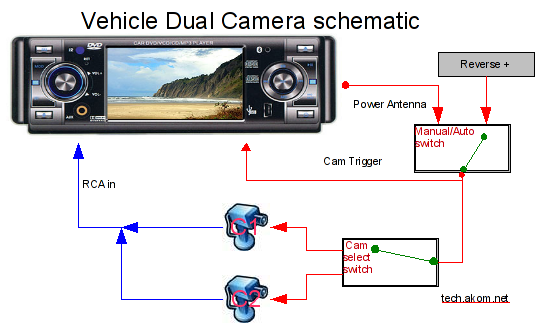Installing two cameras in one vehicle (rear view) with one display
Posted by Admin • Monday, July 27. 2009 • Category: Low Tech HacksNow that I acquired a travel trailer, it was a matter of utmost importance to install a rear view camera on it to ease the process of backing it up. I already have a rear view camera on my van, hooked up to my head unit which happens to have a rear camera input. So the next question is - how do I hook up two camera?
I don't want to give up the one I use all the time in favor of the occasionally used trailer cam. What am I to do? So I had to figure it out.
Requirements
Here are the things I felt were important to achive:
- Automatically on with reverse
- On Demand capability (to be able to leave the camera on even when not in reverse)
- Select camera to show
- Only power a camera when it's being used
- Avoid weird feedback loops like turning on my reverse lights by accident

Implementation
Turned out to be fairly simple.
My radio has a single RCA rear cam input, and one 12V input trigger line (it switches to showing cam image when the line has power). It also has the usual power antenna output which is hot when the radio is on (not just when it's in FM/AM mode). So the goal of this circuit is to activate the cam trigger line only when either camera is on, regardless of why it's on. Additionally, it isolates the reverse wire (which I had to find in my wiring harness) from getting 12V sent into it by accident.

This circuit has two selector switches (SPDT or DPDT will work) and they need to be placed somewhere. In my case, I have a 1.5 DIN radio in a 2 DIN slot, so the adapter frame happens to have some unused space just big enough for micro toggle switches. The Auto/Manual switch either forces the selected cam to stay on all the time (when the radio is on) or leaves it to turn on when I shift into reverse.
Fortunately I did not need to create a switch for the RCA lines - it is fine to leave them both plugged in (through a Y connector) as long as only one camera is powered (which is what we have here).
As a word of caution, this diagram does not show any fuses/relays you may feel are necessary for added safety, though I guess the standard protection the radio itself has is probably sufficient.

hello just ran across this page and it seems perfect for what i want to do. i have a question about the "cam trigger" leg of the diagram. can you tell me what this is in relation to the head unit? i have a kenwood dnx 772bh head unit and i'm not sure if it has this trigger wire, at least without popping it all off to take a look, but if it doesn't, would this diagram still work? thanks for the info and diagram by the way. bernard